As artificial intelligence becomes more ingrained in our daily lives, the ability to distinguish between real and AI-generated images is increasingly crucial. Recent studies indicate that most people struggle with this skill, often failing to accurately identify AI fabrications. Research involving 50,000 participants revealed that individuals correctly identified AI images 76% of the time and real photographs 74% of the time, a result only slightly better than random guessing. Cognitive psychologist Arryn Robbins explains that our evolutionary history has primed us to quickly assess environments for threats, sacrificing precision for speed, which hampers our ability to notice subtle anomalies in AI images. However, experts suggest that slowing down and examining images for at least 10 seconds can improve detection rates. Familiarity with common AI flaws, such as anatomical errors or cultural implausibilities, also enhances our ability to spot fakes. Moreover, reverse image searches can help verify an image’s origin in critical situations. While these strategies can improve accuracy, the key takeaway is to remain humble and cautious, acknowledging our susceptibility to AI deception and taking extra care when evaluating images.
This website uses cookies to improve your experience. We assume you agree, but you can opt out if you wish. Accept More Info


